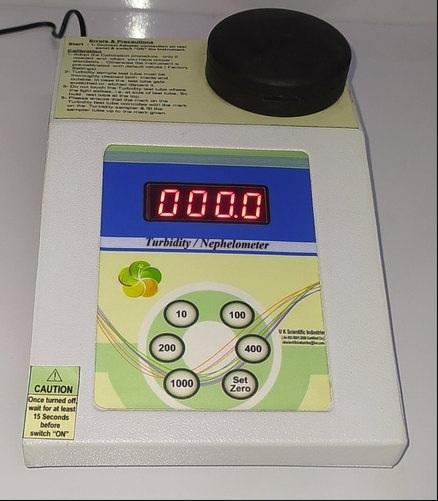A turbidity test of water is performed by using a Nephelo turbidity meter.
A turbidity test of water is performed to calculate the presence of impurities in the water. Turbidity is a measure of the relative transparency of a liquid. This is an optical property of water that measures the amount of light that is scattered by substances in the water as it passes through a sample of water. If the intensity of scattered light is high, the higher the turbidity. In this way turbidity test of water is carried out.
Table of Contents
What is Turbidity of Water?
Turbidity prevents the light to pass through the water. Turbidity of water represents the presence of suspended solids like earth material, silt, clay, organic matter green growth, and different microorganisms.
Nephelo turbidity meter is used to calculate the cloudiness/haziness of water. This is a very important test for water quality. Turbidity is caused by particles of different sizes that absorb light and create a cloudy appearance. The turbidity of the sample increases as the amount of undissolved solids increases.

Turbidity Test of Water
In this article, we will calculate the turbidity of a given water sample by using the Nephelo turbidity meter.

Test Procedure:
The turbidity test is carried out in two steps. The first is the calibration of the Nephelometer and the second is the determination of turbidity of the water sample.
(a) Calibration of Nephelometer:
Select the proper range of NTUs on the Nephelometer, Fill the test tube with distilled water, and set the Nephelometer to zero by adjusting the knobs provided for the zero setting. Now fill the test tube with a standard solution of 40 NTUs and adjust the knob to 40 NTUs.
(b) Determination of turbidity of sample water:
1. Turbidity less than 40 units:
Allow samples to come to room temperature before analysis. Mix the sample to ensure no wayward solids are present. Wait until bubbles disappear and then pour the sample into the turbidity meter tube. Now, read NTU directly from the instrument display or from a calibration curve.
2. Turbidity exceeding 40 units:
When the turbidity of the water sample is 40 units, add more turbidity-free water to the sample until the turbidity falls below 40 units. The turbidity of the test sample is determined from the turbidity of the diluted sample and the dilution factor.
Suppose that five same volumes of distilled water were added to the turbid sample, and the diluted sample showed turbidity of 30 units. Using that information, you can work out the turbidity of the original sample: 180 units.
Nephelometric Turbidity Units (NTU) = A(B + C) / C
Where,
A = Turbidity of diluted sample, B = Volume of diluted sample (ml)
C = Sample volume taken for dilution.
Test Observations:
For undiluted sample For diluted sample
Digital readout = Vol. of sample ( C ) =
Vol. of dilution water ( B ) =
Digital readout ( A ) =
CALCULATIONS:-
For undiluted sample For diluted sample
Turbidity of sample (NTU) = Turbidity in NTU = A(B + C) /C
This was the complete test procedure of turbidity test of water, If you have any confusion you can comment below.
Effects of Turbidity on Human health
Turbidity more than the acceptable limit or cloudiness, in drinking water, is aesthetically unappealing, and may also represent a health concern. Turbidity can provide food and shelter to pathogens. These pathogens can grow rapidly due to high turbidity. These pathogens can lead to waterborne disease outbreaks, which have caused significant cases of intestinal sickness throughout the world.
Turbidity is not a direct indicator of health risk, but many studies demonstrate the strong relationship between the removal of turbidity and the removal of protozoa. Particles present in the turbidity provide a “shelter” for microorganisms to provide the impact on attacks by disinfectants. Microbial adhesion to particulate matter was thought to promote microbial survival. Fortunately, traditional water treatment processes can effectively remove turbidity if used correctly.
Uses of Turbidity Test
- In a water supply system turbidity data can be useful in determining the effectiveness and adequacy of treatment with various coagulants and the required dosage.
- Filter defects can be confirmed by evaluating the turbidity of the filtered water.
- The efficiency of the removal of suspended solids from wastes can be determined by the results of turbidity measurements in treated wastewater.
- To obtain high-quality wastewater with minimal chemical use, turbidity information can be used to adjust or balance chemical amounts.
Happy Learning
Read More Articles:
- Standard Ceiling Height | Ceiling Height of a Room
- Different Test Of Brick
- What are Paver Blocks | Paver Block Types | Concrete Paving Block
- Gable Roof | Types of Gable Roofs | Gable Roof Design
- Sloping Roof | Types of Sloping Roof | Pitched roof
- Different Types Of Arches In Construction
- What Is a Porch | Types of Porch?
- Lump Sum Contract | Benefits of Lump Sum Contract
- Environmental Impact Assessment | What Is EIA
- Difference between Centrifugal Pumps and Reciprocating Pumps
